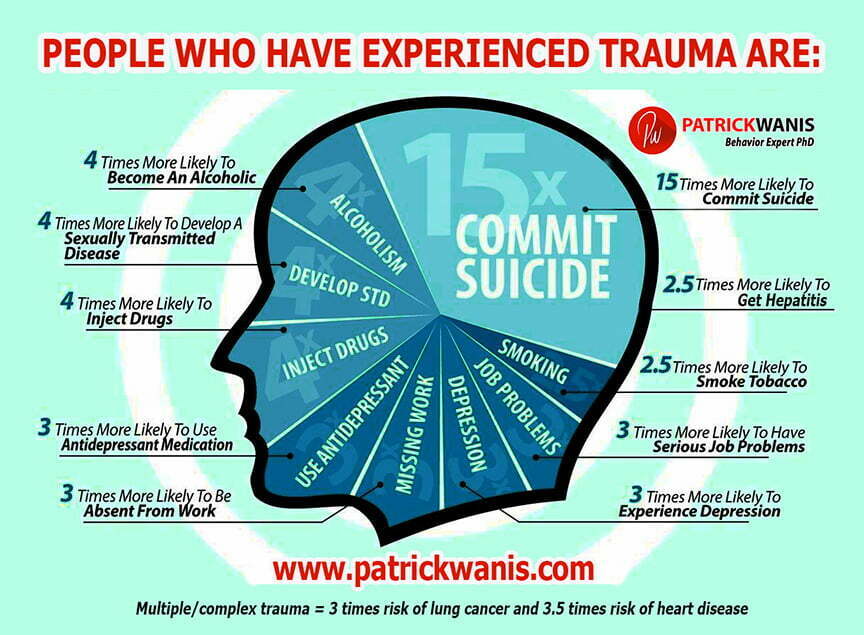In this week’s Success Newsletter, I would like to reveal what trauma really is, the ways it affects your body, brain and health outcomes for life, and the way to heal trauma.
First a quick update:
The Breakup Test
Are you heartbroken, angry, lost, lonely, confused, depressed, or pining over your ex? How would you like to benefit from personalized advice, action steps and revelations? Take my free breakup test and get your own personalized report.
You Can Do It! You Have The Psychological Capital Within You!
Are you struggling to deal with the extreme changes? Are you doubting yourself? Watch the video to learn how to tap into the 4 resources you already possess – Psychological Capital
Now, let’s talk about what trauma really is, the ways it affects your body, brain and health outcomes for life, and, the way to heal trauma.
When you think of trauma, you probably think of psychological pain from war experiences or physical harm from accidents.
What about, though, if I were to ask you if, before you turned 18, you experienced physical, emotional, or sexual abuse; physical or emotional neglect; one of your parents had a mental illness or had an addiction or alcohol problem or was incarcerated; your parents separated or divorced; someone in your family died; you were bullied or; you witnessed domestic violence?
Trauma is the response to feeling intensely threatened or harmed by an event you were involved in or you witnessed. Trauma triggers the body’s stress response (fight, flight or freeze) and it affects the brain and the body: it negatively affects brain development, the immune system, the endocrine system, and the expression of genes.
Childhood trauma has been scientifically shown to dramatically increase the risk for seven out of 10 of the leading causes of death in the United States.
The more trauma you experienced in childhood, the worse your health outcomes will be. For example, if you experienced 4 traumas in childhood, your relative risk of chronic obstructive pulmonary disease is two and a half times that of someone who experienced no trauma, and it’s two and half times greater risk for contracting hepatitis, four and a half times for depression, four times for alcoholism, and up to 15 times greater risk for committing suicide.
There are various forms of trauma – Acute (single event), Multiple (multiple events), Complex (multiple traumatic events that are invasive, and interpersonal – usually severe and pervasive, such as abuse or profound neglect with wide-ranging, long term effects.)
Watch the free webinar on trauma below
Lifelong Impact of Trauma on Health and Wellbeing
Trauma results in:
Depression
Irritability
Anger
Aggression
Apathy, loss of interest in life and pleasurable activities
Numbing
Decreased concentration
Insomnia
Emotional overwhelm
Loss of emotional control
Emotional outbursts
Reduced tolerance to stress
Loss of a sense of the future/ambition
Hopelessness, helplessness
Shame
Worthlessness
People-pleasing
Workaholism/over-achievement
Being a victim of violence or abuse
Little or no memories
Nightmares and flashbacks
Hypervigilance
Mistrust and inability to trust
Fear of others
Generalized anxiety
Panic attacks
Chronic pain
Headaches
Cancer, diabetes, heart disease, lung disease, liver disease, skeletal fractures
Substance abuse
Eating disorders
Addictions
Impulsive behavior
Compulsive behavior
Withdrawal and isolation
Social avoidance/anti-social behavior
Feeling unreal or out of your body
Self-destructive or self-sabotaging behavior
Loss of a sense of self, identity or meaning – Who I am
Early death
Toxic stress physically damages a child’s developing brain
If you are wondering how it could be possible that trauma in childhood could have such devastating results throughout life, consider what trauma actually does. Trauma triggers the stress response (HPA axis), and it affects the brain areas for pleasure and reward, impulse control, learning and emotional regulation. Whenever, the stress response is triggered, the immune system shuts down, digestion slows down or stops, and the body goes into hyperarousal or hypoarousal (disassociation, disconnection, and numbing.) Imagine this response happening on a daily basis in the case of a child who has an abusive parent or is being bullied at home or school.
Imagine a little girl who has extreme attacks of asthma every time her dad gets angry and punches the wall, or children who are diagnosed with ADHD and yet have a long history of childhood trauma. These are all actual cases.
Further, trauma changes the brain and the amygdala is triggered often creating regular fearful states or hypervigilance or aggression, and long term, the stress response designed to be adaptive and protective, becomes harmful and leads to various diseases.
Without effective intervention and treatment, the consequences become lifelong. However, the brain can heal.
Join the free webinar on trauma Friday September 11, 2020 at 7PM Eastern Daylight Time. Click here
Healing from trauma
Neuroplasticity is the brain’s ability to heal and reorganize itself by forming new neural connections. Neuroplasticity makes your brain resilient. It enables you to recover from stroke, injury and birth abnormalities. Neuroplasticity means you can overcome depression, addiction, obsessive compulsive patterns, ADHD and so forth. Remember that the brain is neutral and therefore bad patterns can become entrenched or new empowering patterns can form new neural pathways.
Neuroplasticity can result from:
Traumatic Events
Stress
Social Interaction
Meditation
Emotions
Learning
Paying Attention
Diet
Exercise
New Experiences
Therapy
Therapy that actually works and without reliving pain
Although, there are many forms of Trauma Therapies and healing, unfortunately most are more therapeutic than healing – they are momentarily soothing and comforting but they don’t result in real healing and change.
I have had extraordinary success helping clients heal from trauma using SRTT – Subconscious Rapid Transformation Technique. The technique works because you can safely and gently revisit the traumatic event from a third-person perspective without reliving any of the pain & trauma, and you can safely and easily release the emotional pain and create new beliefs about yourself and the world around you. When you are not reliving or stuck in the pain, it is possible to create new neural pathways and get rapid healing and results. Most clients immediately boast of feeling relieved. And I have been helping set clients free from around the world and over the phone for years.
If you would like to release trauma gently, easily, and quickly, book a one-on-one session with me.
You can add to the conversation below.
I wish you the best and remind you “Believe in yourself -You deserve the best!”
Patrick Wanis Ph.D.
Celebrity Life Coach, Human Behavior & Relationship Expert & SRTT Therapist
Anointed “The Woman Expert” by WGN Chicago, Patrick Wanis PhD is a renowned Celebrity Life Coach, Human Behavior & Relationship Expert who developed SRTT therapy (Subconscious Rapid Transformation Technique) and is teaching it to other practitioners. Wanis’ clientele ranges from celebrities and CEOs to housewives and teenagers. CNN, BBC, FOX News, MSNBC & major news outlets worldwide consult Wanis for his expert insights and analysis on sexuality, human behavior and women’s issues. Wanis is the first person ever to do hypnotherapy on national TV – on the Montel Williams show.


